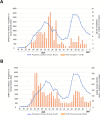Mapping the viral battlefield: SARS-CoV-2 infection dynamics among healthcare workers in Brazil
- PMID: 39934893
- PMCID: PMC11817727
- DOI: 10.1186/s12960-024-00968-z
Mapping the viral battlefield: SARS-CoV-2 infection dynamics among healthcare workers in Brazil
Abstract
Background: Understanding the dynamics of SARS-CoV-2 viral infection and factors associated with in-hospital transmission rates among healthcare workers (HCW) is crucial for their protection. Brazil experienced high mortality rates due to COVID-19, and limited data are available on transmission of SARS-CoV-2 infection among HCW. This cohort study aimed to assess the dynamic of SARS-CoV-2 infections in HCW from two tertiary hospitals in central Brazil, one of them a Reference Hospital for COVID-19.
Methods: From May 2020 to January 2021, 554 HCW directly involved with COVID-19 care were followed through 12 biweekly visits. During these visits, blood, nasal, and oropharyngeal samples were collected, and participants underwent interviews. SARS-CoV-2 detection was carried out using RT-qPCR, while the assessment of seroprevalence was based on IgG detection. Additionally, 35 positive samples underwent viral whole-genome sequencing.
Results: The infection prevalence, as per RT-qPCR, was 28.5% (24.9-32.4), reflecting an overall attack rate ranging from 0.5% to 9.5%, marked by two peaks in August and December 2020. Oligosymptomatic and asymptomatic infections accounted for 14% of prevalent infections. The seroprevalence rate stood at 25.8%. The hospitalization rate was 8.2%, with a fatality rate of 1.3%. Risk factors associated with a positive diagnosis of COVID-19 included being male, working at the referral hospital, having a graduate-education level, and using hydroxychloroquine and zinc for prevention or treatment. One reinfection was identified. Absenteeism was 56.6%. The infection dynamics mirrored the pattern observed in the general population.
Conclusion: One-third of the professionals in the followed cohort were infected. Being male, working in a COVID-19 referral center, having a low level of education, and using medications for preventive treatment represented risk factors. Healthcare workers at the COVID-19 referral hospital exhibited a higher incidence rate compared to those at the non-referral hospital, increasing the plausibility that some of the infections occur in the hospital environment.
Keywords: Asymptomatic infection; COVID-19; Epidemiology; Healthcare worker; SARS-CoV-2.
© 2025. The Author(s).
Conflict of interest statement
Declarations. Ethics approval and consent to participate: This study was approved by the Institutional Review Board of Federal University of Mato Grosso do Sul (CAAE number 31411920.4.0000.0021). Consent for publication: Not applicable. Competing interests: The authors declare no competing interests.
Figures



Similar articles
-
Controlled, double-blind, randomized trial to assess the efficacy and safety of hydroxychloroquine chemoprophylaxis in SARS CoV2 infection in healthcare personnel in the hospital setting: A structured summary of a study protocol for a randomised controlled trial.Trials. 2020 Jun 3;21(1):472. doi: 10.1186/s13063-020-04400-4. Trials. 2020. PMID: 32493494 Free PMC article.
-
Prevalence and incidence of anti-SARS-CoV-2 antibodies among healthcare workers in Belgian hospitals before vaccination: a prospective cohort study.BMJ Open. 2021 Jun 29;11(6):e050824. doi: 10.1136/bmjopen-2021-050824. BMJ Open. 2021. PMID: 34187832 Free PMC article.
-
SARS-CoV-2 seroprevalence in healthcare workers in a tertiary healthcare network in Victoria, Australia.Infect Dis Health. 2021 Aug;26(3):208-213. doi: 10.1016/j.idh.2021.03.004. Epub 2021 Apr 13. Infect Dis Health. 2021. PMID: 33903074 Free PMC article.
-
The role of routine SARS-CoV-2 screening of healthcare-workers in acute care hospitals in 2020: a systematic review and meta-analysis.BMC Infect Dis. 2022 Jul 2;22(1):587. doi: 10.1186/s12879-022-07554-5. BMC Infect Dis. 2022. PMID: 35780088 Free PMC article.
-
Universal screening for SARS-CoV-2 infection: a rapid review.Cochrane Database Syst Rev. 2020 Sep 15;9(9):CD013718. doi: 10.1002/14651858.CD013718. Cochrane Database Syst Rev. 2020. PMID: 33502003 Free PMC article.
References
-
- WHO. Keep health workers safe to keep patients safe: WHO [Internet]. 2022. https://www.who.int/news/item/17-09-2020-keep-health-workers-safe-to-kee.... Accessed 13 Jun 2024.
-
- de Moraes SHM, da Cunha IP, Lemos EF, Abastoflor LLL, Oshiro M de L, Bohrer RTDO de A, et al. Prevalence and associated factors of mental health disorders among Brazilian healthcare workers in times of the COVID-19 pandemic: A web-based cross-sectional study. PLoS One. 2023;18:e0274927. - PMC - PubMed
MeSH terms
LinkOut - more resources
Full Text Sources
Medical
Miscellaneous

